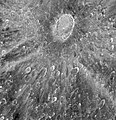File:Moon's impact crater Tycho.jpg

原始檔案 (3,930 × 4,075 像素,檔案大小:5.75 MB,MIME 類型:image/jpeg)
摘要
| 描述Moon's impact crater Tycho.jpg |
English: This mottled landscape showing the impact crater Tycho is among the most violent-looking places on our Moon. But astronomers didn’t aim the NASA/ESA Hubble Space Telescope in this direction to study Tycho itself. The image was taken in preparation for the transit of Venus across the Sun’s face on on 5-6 June 2012.
Hubble cannot look at the Sun directly, so astronomers are planning to point the telescope at Earth’s Moon and use it as a mirror to capture reflected sunlight. During the transit a small fraction of that light will have passed through Venus’s atmosphere and imprinted on that light astronomers expect to find the fingerprints of the planet’s atmospheric makeup. These observations will mimic a technique that is already being used to sample the atmospheres of giant planets outside our Solar System passing in front of their stars. In the case of the Venus transit observations, astronomers already know the chemical makeup of Venus’s atmosphere, and that it shows no signs of life. But they can use the event to test whether their technique has a chance of detecting the very faint fingerprints of the atmosphere of an Earth-like planet around another star. This image shows an area approximately 700 kilometres across, and reveals lunar features as small as roughly 170 metres across. The large bullseye near the top of the picture is the impact crater itself, caused by an asteroid strike about 100 million years ago. The bright trail radiating from the crater were formed by material ejected from the impact area during the asteroid collision. Tycho is about 80 kilometers wide and is circled by a rim of material rising almost 5 kilometers above the crater floor. Because the astronomers only have one shot at observing the transit, they had to carefully plan how the study would be carried out. Part of their planning included these test observations of the Moon made on 11 January 2012. This is the last time this century sky watchers can view Venus passing in front of the Sun, as the next transit will not happen until 2117. The image was produced by Hubble’s Advanced Camera for Surveys. A narrow strip along the centre, and small parts of the upper left part of the image were not imaged by Hubble during its observations, and show data from lower-resolution observations made by a ground-based telescope. |
| 日期 | |
| 來源 | http://www.spacetelescope.org/images/potw1219a/ |
| 作者 | NASA, ESA, D. Ehrenreich (Institut de Planétologie et d’Astrophysique de Grenoble (IPAG)/CNRS/Université Joseph Fourier) |
授權條款
- 您可以自由:
- 分享 – 複製、發佈和傳播本作品
- 重新修改 – 創作演繹作品
- 惟需遵照下列條件:
- 姓名標示 – 您必須指名出正確的製作者,和提供授權條款的連結,以及表示是否有對內容上做出變更。您可以用任何合理的方式來行動,但不得以任何方式表明授權條款是對您許可或是由您所使用。
說明
在此檔案描寫的項目
描繪內容
創用CC姓名標示3.0未本地化 繁體中文 (已轉換拼寫)
7 5 2012
image/jpeg
檔案歷史
點選日期/時間以檢視該時間的檔案版本。
| 日期/時間 | 縮圖 | 尺寸 | 使用者 | 備註 | |
|---|---|---|---|---|---|
| 目前 | 2019年10月19日 (六) 09:16 |  | 3,930 × 4,075(5.75 MB) | BevinKacon | actual size from source |
| 2012年5月8日 (二) 12:39 |  | 1,280 × 1,327(455 KB) | Jmencisom |
檔案用途
下列頁面有用到此檔案:
全域檔案使用狀況
以下其他 wiki 使用了這個檔案:
- en.wikipedia.org 的使用狀況
- ja.wikipedia.org 的使用狀況
- mk.wikipedia.org 的使用狀況
- no.wikipedia.org 的使用狀況
詮釋資料
此檔案中包含其他資訊,這些資訊可能是由數位相機或掃描器在建立或數位化過程中所新增的。若檔案自原始狀態已被修改,一些詳細資料可能無法完整反映出已修改的檔案。
| 製作/提供者 | NASA, ESA, D. Ehrenreich (Institut de Planétologie et d’Astrophysique de Grenoble (IPAG)/CNRS/Université Joseph Fourier) |
|---|---|
| 來源 | ESA/Hubble |
| 簡稱 |
|
| 影像標題 |
|
| 使用條款 |
|
| 資料產生的日期時間 | 2012年5月7日 (一) 10:00 |
| 關鍵字 | Moon |
| 聯絡資訊 |
http://www.spacetelescope.org/ Karl-Schwarzschild-Strasse 2 Garching bei München, , D-85748 Germany |
| IIM 版本 | 4 |
